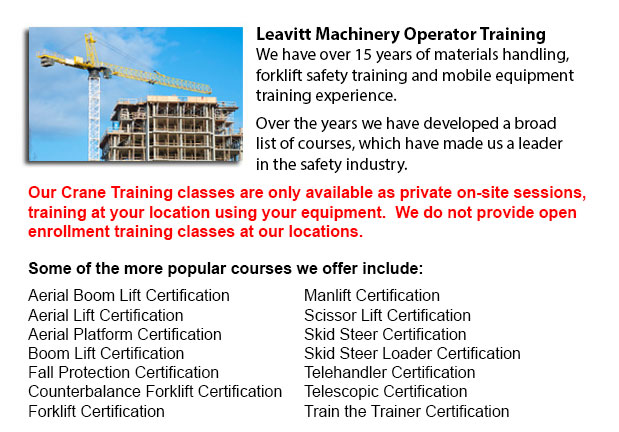
Overhead Crane Operator Training BC - The course teaching overhead crane operator training has been designed particularly to instruct trainees on the basics of pre-shift checks and overhead crane/sling operation. The courses are instructed by professional trainers and consultants. Well-trained employees are more efficient and productive, which actually saves on expenses connected with merchandise damage, property damage, and accidents due to the use of improper operating procedures. Our overhead crane certification is customized for staff who have literacy barriers, reducing certification time by 50 per cent.
The overhead crane has been built to be used doing repetitive hoisting activities. This particular kind of crane can be utilized in many capacities. They can be utilized for specialized lifting jobs like installing or removing major plant equipment.
In order to safely utilize an overhead crane, staff have to employ safe rigging practices. This requires both practice and knowledge. The load should be rigged right to be able to guarantee its stability when lifted. Prior to beginning a hoisting job, it must be determined that the crane is right for the task, with appropriate travel, lift and capacity. The crane needs to be subjected to a thorough physical and visual check before utilization. The capacity of all machinery, including the hardware, rope and slings, should never go over load weight capacities.
Before using the rigger should know what sling is right for each lift and be able to inspect the rigging hardware and gear. The communications which are used with the crane operator have to be clear and concise. A signaler must be designated for the role and signals must be agreed upon. The crane operator needs to follow instructions just from the designated person. If a remote or wired controller is being utilized, the operator must be trained in all its functions.
To be able to guarantee the safety of personnel, a warning has to be issued and the path of the load must be cleared of all obstructions before the lift starts. People must not be allowed to walk under the lift loads. The crane hoist should be centered over the load prior to lifting to prevent swinging. The safety catch must be closed immediately after sliding the sling fully onto the lifting hook. Sling legs which are not used should be secured so they do not drag. Never leave loose materials on a load being lifted. Watch that fingers and hands are clear when slack is taken out of a sling. Step clear of the danger zone before the lift is made.
-
Zoom Boom Ticket BC
Zoom Boom Ticket BC - Zoom Boom Training focuses on correctly training prospective operators on variable reach forklifts. The training objectives include gaining the understanding of the equipments physics and to be able to define the job of the oper... More -
Scissor Lift Training BC
Scissor Lift Training BC - When operating a scissor lift, they should be used competently in order to protect the wellbeing of the other personnel in the workplace and to protect the safety of the equipment. Operators who are skilled are trained to d... More -
Wheel and Track Loader Training in BC
Lift trucks are obtainable in several load capacities and several models. Nearly all forklifts in a regular warehouse surroundings have load capacities between one to five tons. Bigger scale models are used for heavier loads, like loading shipping co... More -
Zoom Boom Training BC
Zoom Boom Training BC - Zoom Boom Training focuses on properly training prospective operators on variable reach forklifts. The training goals consist of gaining the knowledge of the machine's physics and to define the responsibilities of the operator... More -
Heavy Equipment Operator Certification BC
Heavy Equipment Operator Certification BC - The heavy equipment operator is a person who manipulates the controls and drives various types of huge machinery. Heavy machinery is most commonly used on construction sites to deliver supplies to the site... More -
Crane Ticket BC
Crane Ticket BC - New cranes can either be complex or simple, based on the nature of the application they are able to do. For example, mobile cranes are rather simple models. A steel truss and even a telescopic boom mounts its movable platform. A sys... More -
Telehandler Training in BC
Telescopic handlers normally known as telehandlers for short, are a very popular piece of heavy construction machinery. They are commonly utilized in the construction and agricultural industries. These equipments have maximum reaching capacity and ar... More -
Wheel Loader Training BC
Wheel Loader Training BC - Normally, the various types of heavy equipment training are divided into 2 categories of equipment: those which have rubber tires and tracked vehicles. Tracked vehicles comprise items like excavators, cranes, and bulldozers... More

Forklift Training BC
TOLL FREE: 1-888-254-6157
forkliftcertificationbritishcolumbia.com
Email Us
About Us


